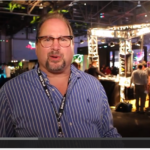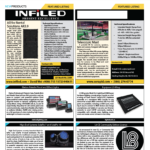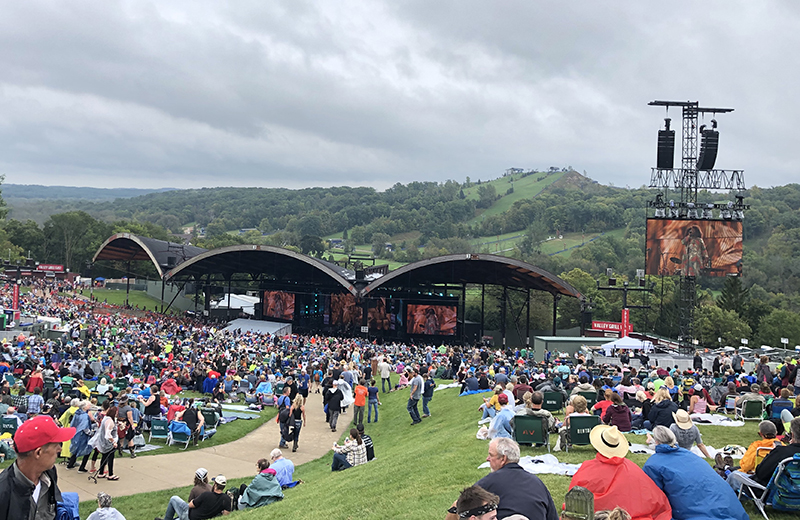
This year marks the 34th anniversary of the Farm Aid Festival. What started out from a remark by Bob Dylan at Live Aid in 1985 — “Why don’t we do a show for American farmers?” — was originally slated as a one-time concert. It launched a movement, a tradition and a nonprofit organization that spreads far beyond the venue where the music is heard raising awareness about the loss of family farms. Grass roots action followed to raise funds to keep farm families on the land.
The once-a-year event has never been tied to one locale or venue. Instead, Ron Stern, who has been the producer of the Farm Aid Festivals from the beginning, says it is “a traveling festival,” with two main criteria to meet regarding each year’s location.
“One of the most important reasons we choose a venue is if we are welcome there and have reasons to come there,” says Stern. “This year, the Alpine amphitheater in Wisconsin seemed the right place due to the particular issues surrounding the dairy farms in the region.” The 2019 event, at Alpine Valley Music Theatre, took place Sept. 21.
“Alpine Valley has been on our radar a long while, but for one reason or another, it never worked out,” says Stern. “The challenge this year to putting on Farm Aid 2019 revolved around the fact that Alpine is one of the earliest amphitheaters built to service the local symphony summer residence. It doesn’t have enough dressing rooms or stage height or space to mount a major production. Consequently, there are huge production issues at Alpine, not the least of which are stage and dock space.
“Don’t get me wrong,” Stern says. “The artists have a beautiful view standing on stage looking up that long hill to the back edge of the lawn, kind of like the Red Rocks experience. Ever since Charlie came on board, we have been expanding our production to reach our audience in a more meaningful way. Basically, we do a stadium show in amphitheaters,” says Stern. A big part of the success of these productions is the long term relationships, built up over their years of touring and working together.
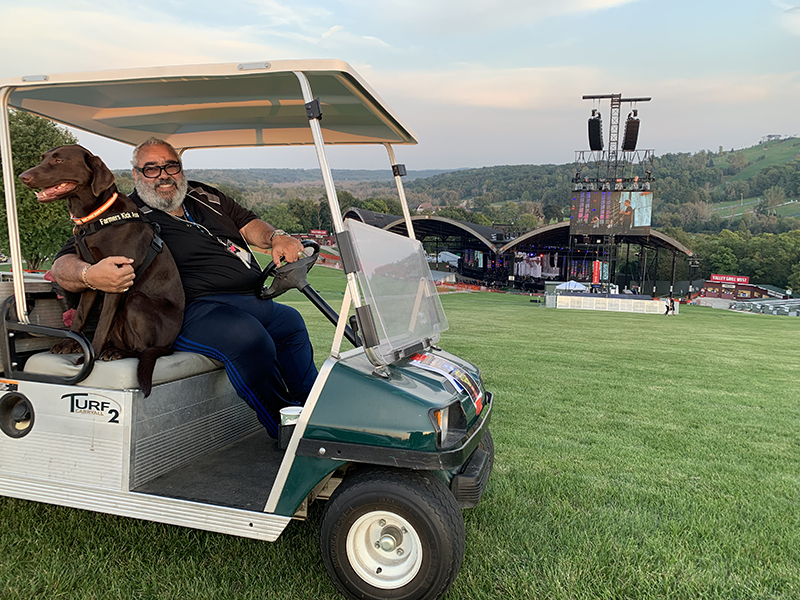
Charlie Hernandez, production manager and designer for Farm Aid, has arranged his other gigs to be available consistently since 2011. He knows all too well the shortcomings of Alpine Valley and was more than a little hesitant, Stern recalls. “After Charlie got over the initial shock when I told him we had booked the Alpine, he came up with a design that was really creative; really worked. Then he gets with Jason Robinson, our lighting and video designer, and just came up with a brilliant plan.” The simple fact staring them in the face was that, above and beyond staging 17 acts on such a tight performance area with a low trim height, those acts all needed their gear and people to hit the stage on time. The surrounding area became a significant factor in making that happen.”
Whatever misgivings Hernandez had about the venue’s ability to host a show that would meet the exacting standards that Farm Aid has set for itself over the years, they were negated after a sit-down with Farm Aid producers Jennifer Fahy, Carolyn Mugar and Glenda Yoder. “What changed my mind was how important they all felt this location to be,” Hernandez says. “I knew things would have to change, but I’m like everyone else; ‘Don’t fix something that’s not broken.’ We had a template that worked, and now we had to adjust that template.”
Hernandez has been supporting Farm Aid events since the festival’s fourth year. As that event, staged at the Hoosier Dome in Indianapolis on April 7, 1990, was being planned, Stern called Hernandez to say he “needed help on this one,” as there were going to be 70 acts. “Once I was introduced to the method of how they did things, I was hooked,” Hernandez says. “One of the great things that happened at that Farm Aid in Indianapolis is Elton John came out and sang ‘Candle in the Wind’ for Ryan White.” It was such a moment, says Hernandez, “that changed all our lives. Elton’s too. Right after that he became sober.”
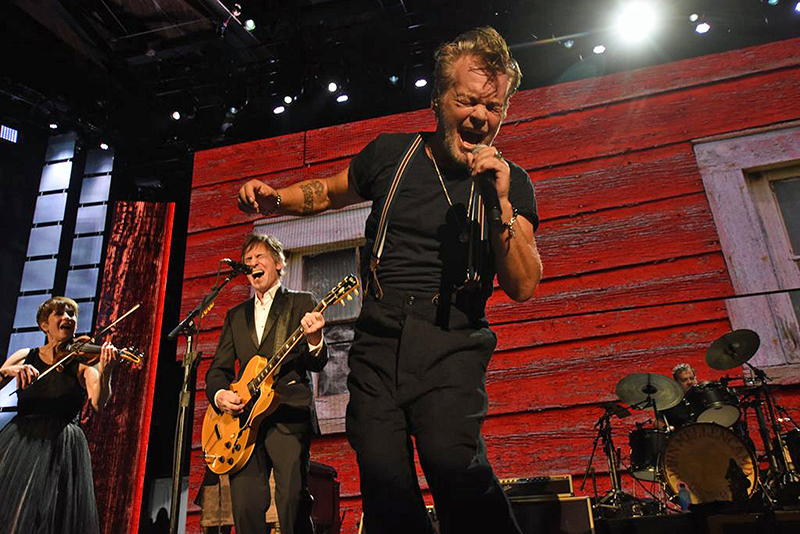
Overcoming the Venue’s Challenges
The Alpine Valley Amphitheater was built on a piece of land that had the advantage of being a natural amphitheater. As the venue got busier, the owners kept extending the lawn space going up the hill away from the stage for the larger and larger audiences. “We are staging a stadium show in a small amphitheater,” Stern points out. “And what Farm Aid promises, what we promise to the artists who come here on their own dime, is to deliver a world class production. We produce their segment specific to them.”
Stern and company work at making this festival one-off as autonomous of a date as possible for each act. “Our intent is to make sure each act is as comfortable as possible.” Clair Global, for example, runs multiple snakes during initial load in for the acts to bring in their monitor and FOH boards, if they want.
To achieve that comfort level, Hernandez and Stern needed to make everything peripheral to getting the bands and gear on stage as seamless as the rapid set changes that take place on stage, even if 90 percent of the bands who are playing show up Saturday morning, the day of the event. In all, more than a dozen buses and trucks filled with gear, crew and artists all need to be sorted out while a load-in is going on behind a press conference on stage with 200 media people and the board members of Farm Aid. So the logistics of getting them into the building to do their bit and get them out of the building is a project unto itself.
“There are a lot of moving parts to this show before, during and after the set changes and performances” says Hernandez. “We accommodate the bands all in an effort to allow them to have as much of their personal ‘bubble’ and give them as much comfort as possible.”
“We always try to put the artist as close to the stage as possible, because a lot of interaction occurs on the stage between players, as guests join the band playing,” adds Stern. “The limited space at Alpine only allowed for Nelson, Young, Mellencamp and Dave Matthews’ bus to be directly backstage.”
Seventeen acts were booked, Stern notes, and Alpine only has three loading docks. Dock space, bus and staff parking space were problems. Stern made a contract conditional that he has access to the large parking lot adjacent to the nearby golf course and the lot at the hotel at the bottom of the hill backstage. “Charlie also designed and implemented a shuttle system that smoothly transitioned the artists from their bus to the stage and back,” Stern adds.
Hernandez came up with an elegant set up to solve the dock problem by building a secondary dock(provided by G2 Structures from NC) location further down the hill backstage which acted as the transition point from touring truck to shuttle truck.
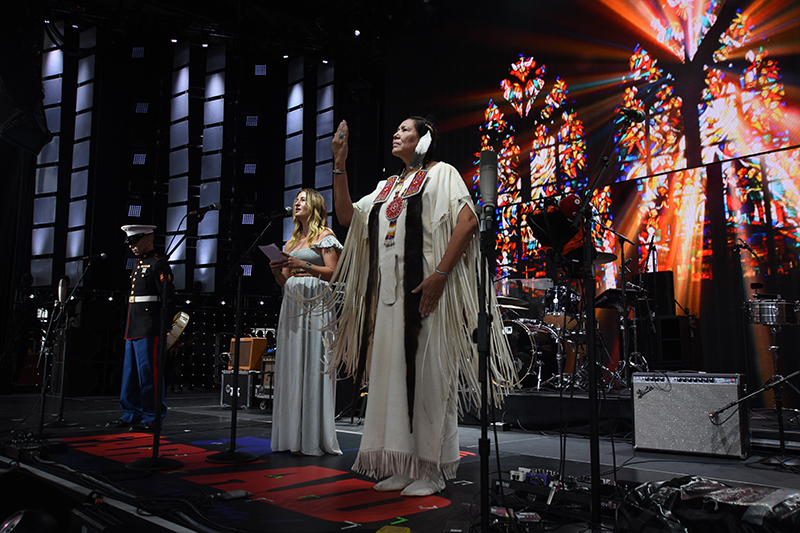
The Players and Vendors
“The bottom line is that everyone comes to this benefit on their own dime,” says Stern. “The artists, the vendors and the technical staff running the show, which largely consists of Charlie’s network of exceptional roadies, is why this thing works. Rich McDonald, our site coordinator is maybe the best I have ever had the opportunity to work with. The Alpine Valley staff was totally on board and I can’t say enough about I.A.T.S.E. Local 18. They did a fantastic job. This was a Live Nation venue, whose amphitheaters we have played many times. They gave us an all star team of their best employees and they contributed greatly to the success of the show.
“With all the Farm Aid shows I have done over the years, this was the best labor experience that I have had in all that time,” Stern continues. “This show was exemplary. The IA was incredible, and the Teamsters came and volunteered to be drivers for all the bands and all the talent vans we needed to make Charlie’s slick shuttle system work. This year the greatest team of vendors and people showed up to make this happen. Couple that with our partnership and trust in the labor that comes in with us,’ cause… we can’t do this by ourselves. “The Farm Aid show reminds me of my roots back in the 70’s when we were all just figuring it out, nobody was more important than another person; everybody has the same goal.”
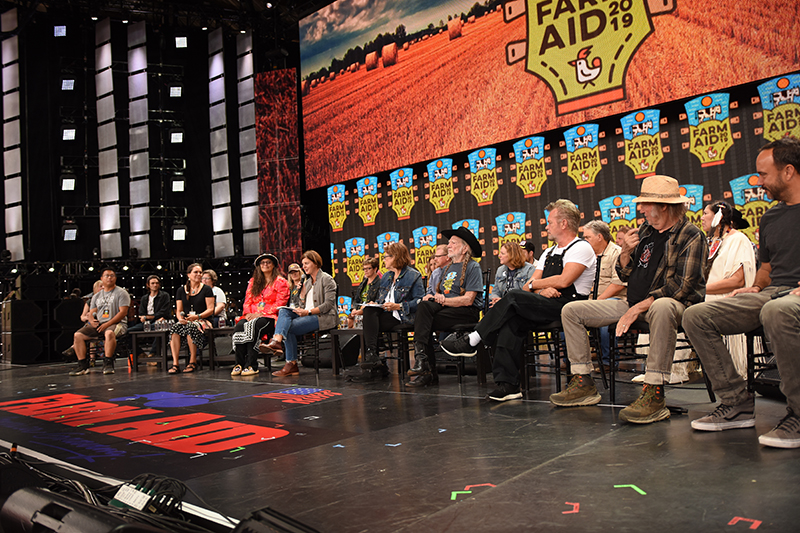
A Lot of Help from a Lot of Players
Many vendors come to the table through experience of prior Farm Aids or having worked with Stern and Hernandez. “AAA Communications has been donating their radios for years and Rock-It Cargo, of course, has always been there for us,”’ Stern notes. Howard Page of Clair Global designed the FOH package and the delay system. He completely re-designed the sound system for the event. Clair brought in a main sound system and more delay towers to integrate with Alpine’s existing delay towers; something which had never been done before. Stern says he has never heard a house PA and delay towers sound the same before. “Howard is the best sound designer I know, he engineered with Clair Global an extraordinary complex sound design to go along with our delay towers which had Solotech LED screens on them to allow for the complete experience of the Farm Aid show to everyone in attendance.
“Our goal has always been to make sure what was happening down stage center could be experienced all the way to the last row,” says Stern. “This venue has never sounded better!” StageCo donated the delay towers for audio and video deployment, and a Chicago company, Stevenson Crane, donated their equipment and people to erect the towers. Solotech provided all the LED screens. Jason Robinson designed the lighting and video presence on the event, and Upstaging once again provided trucking, the lighting, and sent their best people to install. And many other vendors stepped up to the plate (see production credits).
“We put together a one-day multi-act festival, which has layers of a lot of moving parts,” adds Hernandez. “It’s not only the music. Everyone at Farm Aid is involved all year round putting the logistics together. They are instrumental in making the Homegrown Village happen.” The exhibitors in the Village are farmers and farm organizations teaching about the challenges farmers face, and the benefits they bring, from delivering good food to mitigating climate change, and how to connect directly with farmers to make a difference.
“My part of the job is to make the production side, which is a big messaging side to the public, as beautiful and perfect as I can, because they have this one day a year they can do this,” says Hernandez. “There is no fooling around here. Everybody is in on it and donates their efforts, because we all know why we are here.”

The Director’s View
“It all starts with Ron and Charlie,” says Danny O’Bryen, president of Screenworks and video director for Farm Aid. “I have known these guys forever. That is a big part of what makes this work so well. We have all been around the block together. So it is not like a regular TV shoot, which can be a bit of a political killjoy.”
There has been a long history of broadcasting the event since the show began in 1985. When O’Bryen was invited to the party in 2011, Farm Aid was in a transition. At the time, it was a simple webcast, which O’Bryen did out of a flight pack, cutting the show for 12 hours, “I gotta tell you, [that] was a bit of a beating,” he laughs. “Point is, though, I got it. I understand promoter rep speak, I understand seat kills and my angles so the three of us get together and just work it out.” O’Bryen used to tour with Neil Young and has directed multiple shows and DVD with Dave Matthews over the years.
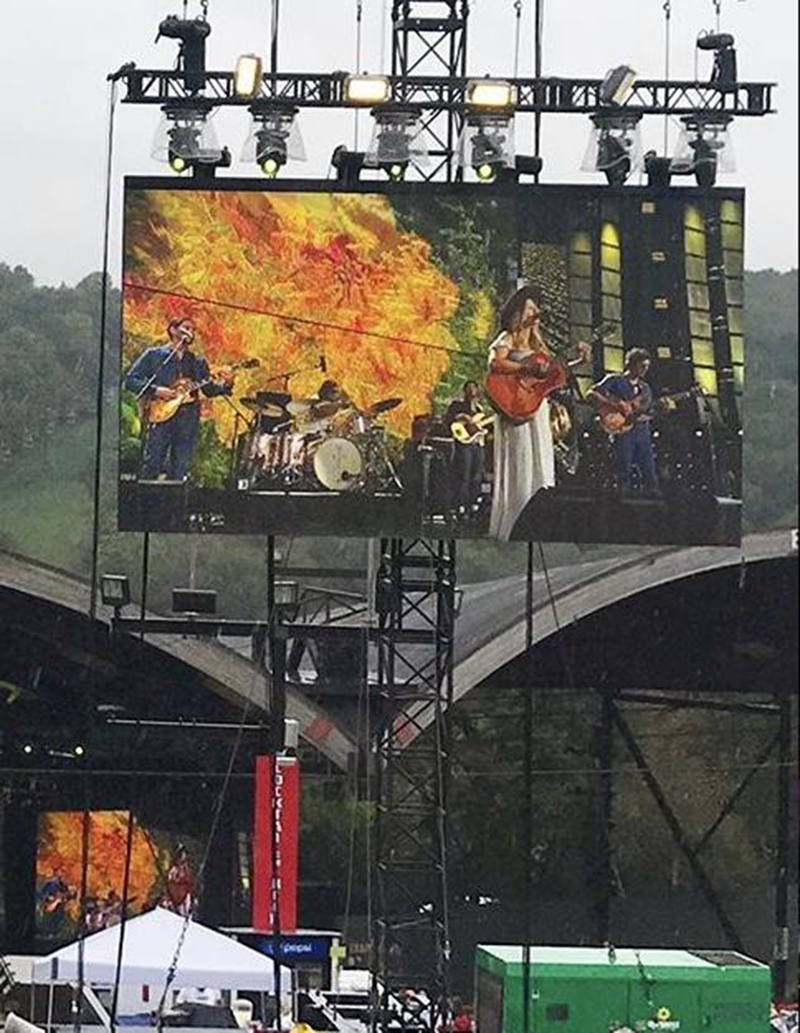
“The key to the look of this show is Jason Robinson,” O’Bryen states. “We start out way above most video shoots because of him and the incredibly beautiful video content the Farm Aid people shoot. Jason loves to do this show, because he does two live TV shows a week (with WWE) and does not get to live concerts very often. He knows servers, he knows color temperature; with Jason at the helm, it is hard to screw this up, because every shot is lit perfectly. He nails it every time!” Stern enthusiastically seconds that. “Jason and Charlie did a fantastic job of scaling this down because of the trim height, and it looked fantastic!”
Brian Lockwood shares the directing duties with O’Bryen. “Brian and I go back a long way and have used this approach many times on DVD shoots with George Strait and Eric Clapton. We have a TD in the truck because there are so many elements to this show. When Brian is directing a band, he calls camera, and Rob Taylor, our TD, cuts it. We then alternate directing acts, and when I slide in there, I cut the show myself.” Consequently, two very different looks happen for the entire broadcast of the show. “My philosophy has always been that we do not impose the video shoot on the show,” says O’Bryen. “We just capture the music.”
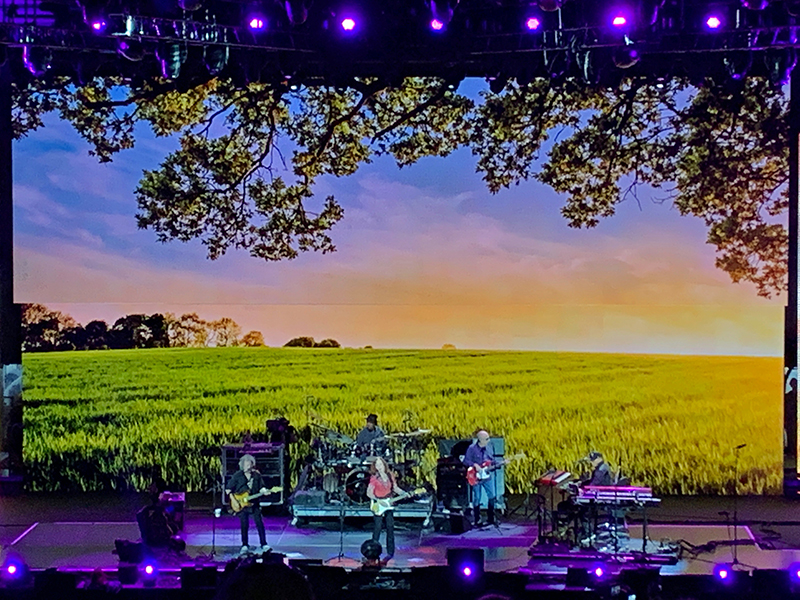
The audience at the venue numbered 30,000-plus for the 2019 event, but the live broadcast brings the focus onto what Farm Aid is trying to accomplish. “We have a long history with AXS TV, and we love working with them as a team. AXS has always respected our event, and we feel the same about them,” adds Stern. “To do 17 acts with no rehearsal and have almost a seamless show — I’m really proud of that,” Stern continues. “And I’m really proud of how we blend our Farm Aid people in with our production people. Nobody is more important. We all work just as hard. It’s a live show, it’s a television show, it’s an internet show, it’s a media show, and it’s a messaging show.”
AXS TV provides the broadcast trucks — a first at Alpine, which added another layer to the complexity for Hernandez and others to figure out and resolve. “What we are doing with that truck is producing three shows at once,” notes O’Bryen. “One is the live feed to the screens with extra messaging for the in house audience. Then we feed the webcast, which is completely separate from what we feed to the screens at Alpine. The third part is a live show on AXS condensed with earlier performances.”

The Core Story
Jennifer Fahy, communications director with Farm Aid and the person who championed Alpine Valley, has been with the organization 17 years after realizing a dream to do work that is ‘more mission oriented.’ She tells of the urban legend that is passed around in the halls of Farm Aid Headquarters in Cambridge MA, near Boston. “Willie organized that first concert in just six weeks.” A few months after Live Aid in ‘85, Willie Nelson was doing a state fair in Springfield IL. He and then-governor James R. Thompson were having a discussion about what Dylan had said, the upshot of which led Thompson to say, “Willie, I’ll give you the college football stadium (which seats 80,000) for free if you can bring the artists.”
Fahy also clarifies what came first — the Farm Aid festival or the Farm Aid organization backing it. “The concert came first, and the Farm Aid organization has become all it is today because of the ongoing concert,” she says. “Willie also had the foresight to hire Carolyn Mugar as a ‘temporary position’ to help him distribute the money” raised for what was conceived as a one-time event.
The first Farm Aid brought in about $7 million while raising awareness in America and beyond about the crisis facing farmers. Traveling extensively with a hands-on approach, Mugar made sure the money went directly to the people on the grounds who are organizing the work. Now, 34 years later, she is the executive director of Farm Aid and the process remains intact.
Looking back, it has become easy to see that while the $7 million raised the first year was substantial, it hardly put a dent in the total debts faced by America’s small farmers. Fahy emphasizes that simply paying off their debt was never the intent, however. “The concert has a major impact on the work Farm Aid is able to do all year. It allows us to be the organization we are today. The commitment of the artists and our board of directors, to donate their talents to come and play for free makes all our work possible.” Board members include David Anderson, Paul English, Richard Fields, Joel Katz, Dave Matthews, John Mellencamp, Lana Nelson, Willie Nelson, Mark Rothbaum, Evelyn Shriver and Neil Young.
Hernandez sums up the overall effort. “Look, when Farm Aid started, we were naïve enough to think we could solve it all in four or five years,” he says. “Here we are, 34 years later, and there is still so much work to do.”
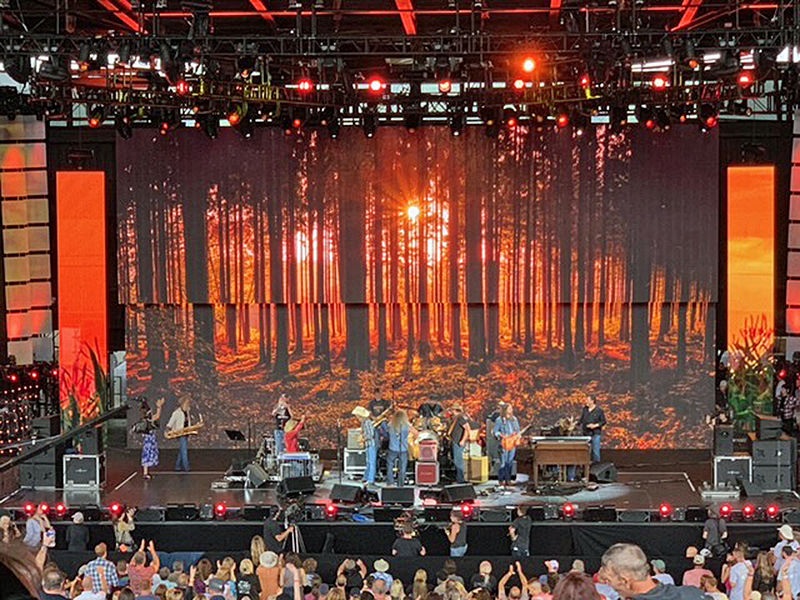
Production Credits
- Executive Producer: Willie Nelson
- Creative Director: Mark Rothbaum
- Producers: Ron Stern, Carolyn Mugar, Glenda Yoder, Jennifer Fahy
- Prod. Manager: Charlie Hernandez
- Site Coordinator: Rich MacDonald
- The Roadies: Dug Wuest, Chris Deters, Scott Grebe, Rob Richards, Michael Washer, Michele Morin, Nick Foster, Heather Rogan, Tom Davis, Matt Monahan, Mathew Fulkerson
- Production Rigger: Bart Durbin
- Artist Stage Mgr: Megan MacDonald
- Production Coordinators: Andrea Fulkerson, Jean Dalsin, Maya Gas
- Artist Advance: Vicki Krone
- Talent Coord: Kim Taylor, Mike Krone
- Artist Hospitality: Esther Bloch
- Ground Transportation: Brian Market
- Credentials: Aaron Bach, Arnett Designs
- Security: Steve MacDonald
- Lighting: John Huddleston, Upstaging
- Lighting Crew: Mike Hosp, Josh Wagner, Jonathan Garcia, Tim Grandt, Ashley Gauger
- Lighting Designer/Director: Jason Robinson
- Lighting Design Operations: Christopher Keene, Ross McNamara, Troy Eckerman, Alex Seiler, Chad Lussier
- Sound: Clair Global: Troy Clair, Robert Drewes, M.L Procise (1985-2014), Greg Hall
- Sound Crew: Howard Page, Simon Bauer, Thomas Huntington, James Bump, Jerrell Evans, Nicholas Chmela, Joshua Weibel, Jonathan Yochem, Chuck Smith, Kevin Leas, Thomas, Ford, Amy Bammarito, James Hall
- Video Screens: Solotech: Todd LePere, Leon Roll, Peter Moll
- Solotech Crew: Abe Main, Brandon Dolderer, Rob Brewer, Austin Colby, Tim Mattefs, Josh Phebus, Bryan Keyes
- Video Director: Danny O’Bryen
- Screenworks Video Crew: Brian Lockwood, Ryan Ratajczak, Rob Taylor, Steven Hagerty, Brian Littleton, Joe Weir, Jaime Cantrell
- Video Monitors: Solotech: Todd LePere, Leon Roll, Peter Moll
- StageCo Delay Towers: Mary Lou Figley, Hedwig Demeyer, Farley Gross, Austin Brown
- Backline: Clair Backline
- Backline Crew: Gabe Monago
- Audio Recording: Metro Mobile Recording, Timothy Powell
- Audio Recording Crew: Mike, Konopka, Art Harrison, Peter “Paris” Lahr
- Trucking: Upstaging Trucking/Robert Carone, Robin Shaw, Chanon DiCarlo, Jennifer Clark, Evan Lawrence
- Shomotion: Michael Scherkenbach
- Staging: Tait/Michael Tait, James Fairorth, Matt Hales
- Satellite Loading Dock: G2 Structures/Jim Brammer
- Comms: AAA Communications/ Ronnie Martinelli, Lori Raccioppi, Linda Shepard
- Camera Operators: Brian Littleton , Jamie Kantrell, Scott Lutton
Farm Aid Board of Directors: David Anderson, Paul English, Richard Fields, Joel Katz, Dave Matthews, John Mellencamp, Lana Nelson, Willie Nelson, Mark Rothbaum, Evelyn Shriver, Neil Young
For more information, visit www.farmaid.org.
